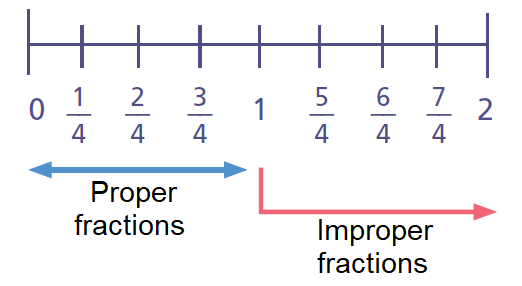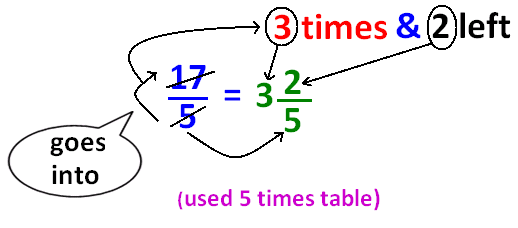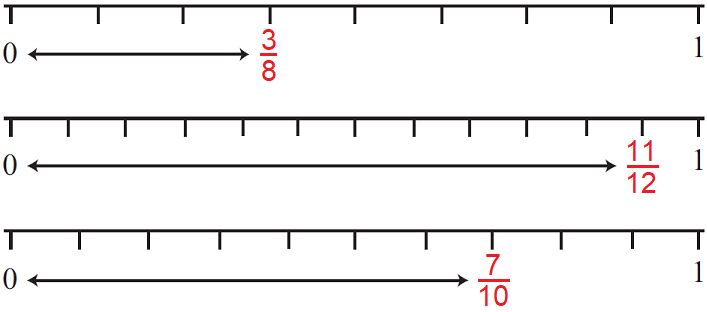WORKSHEET ON TYPES OF FRACTIONS
Question 1 :
What is proper fraction ? Given an example.
Question 2 :
What is improper fraction ? Given an example.
Question 3 :
What is mixed number or mixed fraction ? Given an example.
Question 4 :
What is the difference between a proper fraction and an improper fraction in value ?
Question 5 :
What are like fractions ? Give an example.
Question 6 :
What are unlike fractions ? Give an example.
Question 7 :
What are equivalent fractions? Give an example.
Question 8 :
Classify the values given below as proper fraction, improper fraction and mixed fraction.
2/3, 5/2, 5½, 7/8, 0.2, 1.3
Question 9 :
Explain how to convert an improper fraction to a mixed number.
Question 10 :
Represent the following fractions on a number line.
3/5, 11/12 and 7/10

Answers
1. Answer :
If the numerator of a fraction is smaller than the denominator, then the fraction is called as proper fraction.
Example : 2/3
2. Answer :
If the numerator of a fraction is larger than the denominator, then the fraction is called as improper fraction.
Example : 3/2
3. Answer :
An integer and a proper fraction together is called a mixed number or mixed fraction.
In other words, mixed fraction is a quantity which is expressed as a whole number and a proper fraction.
Always its value will be greater than or equal to 1.
Example : 2¾
The picture given below clearly illustrates this.

4. Answer :
The following is the difference between a proper fraction and an improper fraction in value.
Proper Fraction
The value of a proper fraction will always be smaller than 1.
Improper Fraction
The value of an improper fraction will be equal to 1 or larger than 1.
The picture shown below clearly illustrates this.

5. Answer :
In two or more fractions, the denominators (bottom numbers) are same, they are called like fractions.
Example :
1/2, 3/2, 7/2, 9/2
In the above fractions, all the denominators are same. That is 2.
6. Answer :
In two or more fractions, the denominators (bottom numbers) are different, they are called unlike fractions.
Example :
1/3, 4/5, 1/7, 9/11
In the above fractions, the denominators are different. They are 3, 5, 7 and 11.
7. Answer :
Take 1/2 and you can see that the denominator is twice the numerator. So, any fraction where the denominator is twice the numerator is equivalent (the same as) a half. So
are all equivalent fractions that mean 1/2.
When a half is written as 1 over 2 rather than 2 over 4, or 5 over 10, or any other version, it is said to be in its lowest term or simplest form. This is because no number, except 1, will divide into both the top number and the bottom number. So to put a fraction in its lowest form, you divide by any factors common to both the top number and the bottom number.
Equivalent fractions can be found for any fraction by multiplying the top number and the bottom number by the same number. For example, if you have 3/4, then multiplying by 2 gives
or by 3 gives
Multiplying by 10 gives
and all of these fractions are exactly the same as 3/4.
8. Answer :
2/3, 5/2, 5½, 7/8, 0.2, 1.3
2/3 -----> Proper fraction
5/2 -----> Improper fraction
5½ -----> Mixed fraction
7/8 -----> Proper fraction
0.3 = 3/10 -----> Proper fraction
1.3 = 13/10 -----> Improper fraction
9. Answer :
The picture given below illustrates, how to convert an improper fraction into mixed number.

10. Answer :

Kindly mail your feedback to v4formath@gmail.com
We always appreciate your feedback.
©All rights reserved. onlinemath4all.com
Recent Articles
-
Trigonometry Reciprocal Identities
Apr 28, 24 10:10 AM
Trigonometry Reciprocal Identities -
IB Diploma Mathematics Problems on Exponents
Apr 28, 24 05:42 AM
IB Diploma Mathematics - Problems on Exponents -
Finding Vertex of a Quadratic Function Worksheet
Apr 27, 24 11:06 AM
Finding Vertex of a Quadratic Function Worksheet